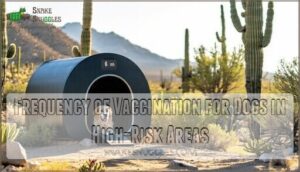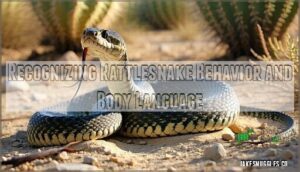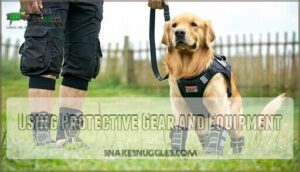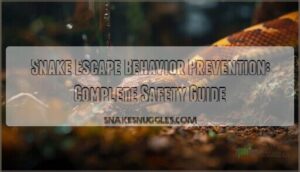This site is supported by our readers. We may earn a commission, at no cost to you, if you purchase through links.

It’s like giving your dog a head start in the fight against snake bites, reducing venom severity and buying vital time to reach emergency care.
This isn’t a get-out-of-jail-free card though – you’ll still need immediate veterinary treatment if a bite occurs.
The vaccine works best for dogs living in snake country, particularly the Southwest where rattlers are common neighbors.
Your vet will typically recommend an initial two-shot series followed by yearly boosters. However, effectiveness varies between individual dogs, and proper timing makes all the difference.
Table Of Contents
- Key Takeaways
- What is The Rattlesnake Vaccine?
- Benefits of The Rattlesnake Vaccine
- Drawbacks of The Rattlesnake Vaccine
- How is The Rattlesnake Vaccine Administered?
- Who Should Get a Rattlesnake Vaccine for Their Dog?
- What Can You Do to Prevent Snake Bites?
- Rattlesnake Vaccination Schedule for Dogs
- Precautions When Considering This Vaccine
- Frequently Asked Questions (FAQs)
- Is the rattlesnake vaccine worth it for dogs?
- How much does a rattlesnake vaccine cost for dogs?
- How long does a rattlesnake shot last for a dog?
- What age is the rattlesnake vaccine given?
- Is the rattlesnake vaccine for dogs worth it?
- How much does the rattlesnake vaccine cost for dogs?
- Can you vaccinate dogs for rattlesnakes?
- How long does a rattlesnake vaccine for dogs last?
- Can puppies receive the rattlesnake vaccine?
- How does the vaccine affect older dogs?
- Conclusion
Key Takeaways
- You’ll get partial protection, not complete immunity – The rattlesnake vaccine reduces bite severity and buys you precious time to reach emergency vet care, but your dog still needs immediate veterinary treatment after any snake bite.
- Your dog needs proper timing and regular boosters – Start with two initial shots a month apart when your pup is at least 4 months old, then schedule annual boosters 30 days before rattlesnake season begins in your area.
- You’re only protected against specific rattlesnake species – The vaccine works primarily against Western Diamondback Rattlesnakes with some cross-protection for similar species, but won’t help against Mojave rattlesnakes, coral snakes, or other venomous snakes.
- You should consider it if you’re in high-risk areas – The vaccine makes sense if you live in the Southwest or frequently hike, camp, or spend time outdoors where rattlesnakes are common, but isn’t necessary for dogs with minimal outdoor exposure.
What is The Rattlesnake Vaccine?
The rattlesnake vaccine, known as Crotalus Atrox Toxoid, is a veterinary vaccine made from inactivated western diamondback rattlesnake venom that helps your dog’s immune system produce antibodies against snake bites.
The rattlesnake vaccine gives your dog a fighting chance against venomous bites, buying precious time to reach emergency care.
While it doesn’t provide complete immunity, this vaccine can reduce the severity of rattlesnake bites and potentially save your pet’s life by giving you more time to reach emergency veterinary care, which can be a life-saving measure.
Components of The Rattlesnake Vaccine
Regarding rattlesnake vaccine components, you’re looking at a carefully crafted formula.
The Crotalus Atrox Toxoid contains inactivated venom from western diamondback rattlesnakes, manufactured by Red Rocks Biologics under USDA license.
Adjuvant components like aluminum hydroxide boost your dog’s immune response, while preservative ingredients including thimerosal maintain stability.
This vaccine manufacturing process creates animal antibodies through controlled antibody production, giving your pet cross-protection against multiple rattlesnake species.
Mechanism of Action
Looking at the vaccine’s components, let’s explore how this rattlesnake vaccine actually works inside your dog’s body.
The vaccine triggers your dog’s immune system to recognize rattlesnake venom as a threat. This process creates specific antibodies that can neutralize venom toxins before they cause severe damage.
The neurotoxic venom can cause paralysis.
The vaccine efficacy depends on several key mechanisms:
- Antibody production – Creates protective proteins against venom
- Immune response – Activates your dog’s natural defense system
- Venom neutralization – Reduces toxin impact on tissue
- Cross-protection – Provides defense against similar snake venoms
Species of Rattlesnakes It Protects Against
The rattlesnake vaccine specifically targets Western Diamondback Rattlesnake venom through its Crotalus Atrox Toxoid formula.
The Diamondback Protection extends to several rattlesnake species including Southern Pacific, Northern Pacific, Great Basin, Timber, and Prairie rattlesnakes due to similar venom properties.
However, Vaccine Limitations are significant. You won’t get Other Snake Protection against Mojave rattlesnake, coral snakes, cottonmouths, or copperheads.
Geographic Variations in snake populations mean Rattlesnake Species Coverage varies by region.
History of Development and Approval
Understanding how this rattlesnake vaccine came about reveals an interesting backstory.
Walliss Discovery began when Dr. Dale Wallis nearly lost her cats to rattlesnake bites in the early 2000s.
Here’s the development timeline:
- 2003 – First Commercial Venom Vaccine licensed by USDA
- 2004 – Nationwide approval for Crotalus Atrox Toxoid by Red Rock Biologics
- 2024 – License Expiration prompted Reinstatement Efforts with USDA Involvement
Benefits of The Rattlesnake Vaccine
You’ll find the rattlesnake vaccine offers several key advantages that can make the difference between life and death for your dog.
While it doesn’t provide complete immunity, this vaccine substantially reduces bite severity, increases survival rates, and gives you precious extra time to get your pet to emergency veterinary care, which can be the difference between life and death.
Reduced Severity of Snake Bites
When your dog gets bitten by a rattlesnake, the rattlesnake vaccine acts like a shield, substantially reducing pain reduction and tissue damage.
The rattlesnake vaccine acts like armor for your dog—reducing pain and tissue damage when every second counts.
The vaccination helps minimize severe swelling and internal bleeding that typically follows a dog rattlesnake bite**.
While you’ll still need professional snake bite treatment and possibly rattlesnake antivenom, vaccinated dogs often require less antivenin, reducing antivenin needs.
This head start gives you precious time to reach emergency care while limiting bite complications that could otherwise cause permanent harm.
Following a snake bite, it’s vital to perform immediate snake bite first aid.
Increased Chance of Survival
When your pup faces a rattlesnake bite, the vaccine acts like a lifeline.
Studies show vaccinated dogs have improved survival rates compared to unvaccinated ones.
Here’s how the rattlesnake vaccine boosts your dog’s chances:
- Buys precious time before antivenin treatment arrives
- Reduces venom absorption into your dog’s bloodstream
- Minimizes tissue damage around the bite area
- Decreases need for intensive post-bite care
- Provides owner peace of mind during emergencies
Decreased Risk of Long-term Complications
Beyond survival, the rattlesnake vaccine substantially reduces your dog’s risk of devastating long-term health issues.
By strengthening antibodies and enhancing immune system response, vaccine effectiveness helps prevent severe complications that can plague pets for months or years after a bite.
| Complication Type | Without Vaccine | With Vaccine |
|---|---|---|
| Organ Damage | High risk to kidneys, liver | Reduced severity |
| Chronic Pain | Persistent discomfort | Minimized duration |
| Mobility Issues | Joint/muscle problems | Better recovery |
| Neurological Effects | Nerve damage | Less likely |
| Amputation Risk | Tissue death requiring surgery | Decreased chance |
This protection maintains your dog’s quality of life and prevents costly ongoing treatments that drain both emotions and wallets.
Cross-protection Against Other Rattlesnake Venoms
Your rattlesnake vaccine offers some cross-protection beyond Western Diamondback Rattlesnake venom, though Species Specificity creates real limitations.
The canine snake vaccine shows Cross-reactivity Studies suggesting partial protection against related species, but Venom Variability means Limited Protection remains the reality.
- Prairie rattlesnakes show documented cross-protection
- Timber rattlesnakes may receive partial coverage
- Mojave rattlesnakes offer zero protection
- Eastern diamondbacks aren’t guaranteed coverage
- Future Research continues exploring broader snake venom protection
Drawbacks of The Rattlesnake Vaccine
While the rattlesnake vaccine offers valuable protection, you’ll need to understand its limitations before making your decision.
The vaccine doesn’t provide complete immunity and won’t eliminate your need to seek immediate veterinary care if your dog gets bitten.
Limited Immunity and Need for Immediate Medical Attention
While the rattlesnake vaccine offers valuable protection, it doesn’t create complete immunity against snake bites.
Vaccine Limitations mean your dog still needs immediate Emergency Care after any bite, regardless of vaccination status.
Don’t let False Security delay treatment – the vaccine may reduce Bite Severity, but Veterinary Care remains absolutely necessary.
Think of vaccination as buying precious time, not eliminating risk entirely.
Variability in Effectiveness Among Dogs
Even with the rattlesnake vaccine, your dog’s individual response varies substantially.
Think of immune systems like fingerprints—each one’s unique.
Understanding the variability in vaccine effectiveness among dogs reveals troubling realities:
- Autoimmune diseases can severely dampen your dog’s immune response to vaccination
- Smaller breeds face higher venom concentrations, making protection less reliable
- Genetic variations in antibody production affect how well the vaccine works
- Stress and poor health suppress immune function, reducing vaccine effectiveness
These health factors highlight why vaccination isn’t foolproof protection.
Possible Side Effects and Adverse Reactions
Most dogs handle the rattlesnake vaccine well, but you’ll want to watch for potential reactions.
Common rattlesnake vaccine side effects include swelling at the injection site, mild fever, and flu-like symptoms like lethargy or decreased appetite.
While serious allergic reactions and anaphylaxis are rare, they’re owner concerns worth noting.
Monitor your pup closely for 24-48 hours after vaccination, as vaccine reactions typically resolve on their own, but contact your vet if symptoms persist or worsen—it’s better to be safe than sorry.
Limited Protection Against All Venomous Snakes
While side effects are manageable, the rattlesnake vaccine coverage has geographic limitations.
Species uncovered include coral snakes, cottonmouths, and eastern diamondbacks.
Your dog gets protection mainly against western diamondback rattlesnake venom, with some cross protection for copperheads.
Venom variation between snake species means bite location and snake type still determine severity.
Even vaccinated dogs need immediate antivenom treatment after any snake bites.
How is The Rattlesnake Vaccine Administered?
If you’re considering the rattlesnake vaccine for your dog, you’ll need to understand the specific administration process to guarantee proper protection.
Your veterinarian will give your dog two subcutaneous injections about a month apart, followed by annual boosters timed before rattlesnake season begins.
Dosage and Vaccination Schedule
While understanding the vaccine’s limitations matters, knowing the proper dosage and vaccination schedule guarantees your dog gets maximum protection.
The rattlesnake vaccine follows a specific timeline that’s easier than you might think.
Your dog needs two initial doses spaced about a month apart, then annual vaccination with boosters every six months in high-risk areas.
- Initial doses: Two shots given 2-4 weeks apart for dogs over four months old
- Booster frequency: Annual revaccination, or every six months for extended exposure periods
- Seasonal timing: Schedule boosters 30-45 days before rattlesnake season begins
- Schedule adjustments: Veterinarians may modify timing based on your dog’s lifestyle and geographic risk factors
Recommended Booster Shots
Your dog needs annual boosters to maintain rattlesnake vaccine protection.
Most vets recommend scheduling these booster shots about 30 days before rattlesnake season begins.
However, if you live in warmer climates where snakes stay active year-round, your vaccination schedule might require boosters every six months for maximum vaccine efficacy and continuous protection.
Timing of Vaccination in Relation to Rattlesnake Season
Timing your dog’s rattlesnake vaccine boosters perfectly means scheduling them 30 days before peak snake season.
This pre-season vaccination approach guarantees antibodies reach protective levels when your pup needs them most.
The protection timeline typically spans six months, making booster timing vital for geographic areas where exposure considerations vary throughout the year.
Frequency of Vaccination for Dogs in High-Risk Areas
High-risk dogs need more frequent protection than their suburban counterparts.
If your dog regularly explores rattlesnake territory, here’s what works:
- Initial Series: Two doses four weeks apart before snake season
- Booster Timing: Every six months for year-round exposure
- Geographic Impact: Desert dwellers need more frequent shots than occasional hikers
- Lifestyle Factors: Hunting dogs require the most aggressive schedule
The instructions provided are designed to protect dogs from rattlesnake bites, considering factors such as geographic location and lifestyle.
Who Should Get a Rattlesnake Vaccine for Their Dog?
You’ll want to evaluate the rattlesnake vaccine if your dog spends time outdoors in areas where these venomous snakes live, particularly in the Southwest where encounters are most common.
The decision depends on your dog’s age, health status, lifestyle, and how often they’re exposed to rattlesnake habitats during hiking, camping, or backyard adventures.
Age and Breed Requirements
Once your dog hits four months old, they’re ready for the rattlesnake vaccine.
No breed restrictions exist, but timing matters for different dogs.
| Age Guidelines | Breed Considerations |
|---|---|
| Puppies: 4+ months minimum | All breeds can receive vaccine |
| Senior dogs: Same schedule applies | Small breeds may need delayed timing |
| Peak protection: 30-45 days | Large breeds handle venom better |
| Annual boosters recommended | Outdoor breeds face higher risk |
Health Status and Contraindications
Beyond age requirements, your dog’s overall health determines vaccine safety.
Dogs with compromised immune systems or pre-existing conditions face higher vaccination risks.
Key health factors to discuss with your vet:
- Immune Response – Dogs on steroids or immunosuppressive drugs may not respond effectively
- Vaccine Reactions – Previous allergic reactions to vaccines increase future risks
- Chronic Illness – Heart, kidney, or liver disease can complicate vaccine responses
- Recent Surgery – Recovery period affects immune system strength
- Current Medications – Some drugs interfere with proper immune response
Healthy dogs handle rattlesnake vaccine side effects better than compromised ones.
Geographic Location and Rattlesnake Prevalence
Most dog owners living in high-risk areas should seriously consider the rattlesnake vaccine.
Endemic areas like Arizona, California, and Texas show significant regional snakebite risk due to seasonal prevalence patterns.
Urban encounters occur even in suburban neighborhoods near desert habitat types.
Your geographic location directly determines your dog’s exposure risk, making vaccination decisions clearer for those in rattlesnake-heavy regions.
These regions align with the rattlesnake’s geographic range, which is an important factor to consider for vaccination decisions and understanding the regional snakebite risk.
Lifestyle and Exposure to Rattlesnakes
Your dog’s outdoor activities directly influence their need for the rattlesnake vaccine.
Rural living and frequent hiking habits put pets at higher risk for snake encounters.
Consider vaccination if your dog experiences:
- Regular trail adventures in high-risk areas
- Unsupervised backyard time in snake territory
- Camping trips where geographic risk increases.
Every dog breed deserves protection from potentially deadly snake bites.
What Can You Do to Prevent Snake Bites?
While vaccination can reduce bite severity, you can’t rely on it alone to protect your dog from rattlesnakes.
The best defense combines smart prevention strategies with staying alert during outdoor activities, especially in areas where these venomous snakes naturally live, which is the best way to provide complete protection.
Avoiding High-Risk Areas and Habitats
Smart habitat identification keeps your dog safer than any rattlesnake vaccine alone. Stay on marked trails during hikes, avoiding tall grass and rocky crevices where snakes hide.
Yard management means clearing brush piles and debris that attract rodents. Snake-proofing involves checking areas before letting dogs explore. A key aspect is to understand rattlesnake natural environments.
Stay on trails Minimized encounters
Keep yard clear of debris
Observe pet behavior when outdoors
Awareness training prevents most high-risk area encounters.
Recognizing Rattlesnake Behavior and Body Language
Beyond steering clear of snake hangouts, you’ll want to decode rattlesnake body language for better dog snake protection.
Rattlesnake postures reveal their intentions—watch for coiled positions and raised heads as strike indicators. Warning signs include rapid tongue flicking and that telltale rattle. Defensive behaviors like "S-shaped" positioning signal danger ahead.
Understanding rattlesnake strike indicators is essential for safety.
Key rattlesnake avoidance signals to recognize:
- The rattle – Nature’s alarm bell warning you to back away immediately
- Coiled stance – A loaded spring ready to strike at lightning speed
- Raised head – Your cue to create distance before a dog snake encounter escalates
Using Protective Gear and Equipment
Learning snake behavior keeps you alert, but proper gear adds another layer of protection for you and your dog.
Start with over-the-ankle boots and thick pants when hiking.
Your dog needs snake-proof leggings and protective dog vests designed for outdoor adventures.
These barriers can prevent fangs from reaching skin.
Consider snake detection devices that alert you to nearby serpents.
These devices can help with early snake detection.
Training collars help with rattlesnake avoidance commands during hikes.
Don’t forget first-aid kits for emergencies.
Snake-proofing yards with proper fencing reduces home risks too.
Detection Devices battery maintenance
Educating Children and Family Members
Keeping your family informed about snakebite awareness transforms everyone into your dog’s safety team.
When kids understand rattlesnake dangers, they become vigilant protectors during outdoor adventures.
Essential pet safety education includes:
- Never approach or touch any snake – even "dead" ones can bite
- Listen for rattling sounds before exploring new areas
- Stay on marked trails and avoid tall grass or rock piles
- Make noise while hiking to warn snakes of your presence
- Keep dogs leashed in rattlesnake territory for better control
Rattlesnake Vaccination Schedule for Dogs
You’ll need to follow a specific vaccination timeline to give your dog the best protection against rattlesnake bites.
The schedule starts with two initial doses about a month apart, followed by annual boosters timed before rattlesnake season begins.
Initial Vaccination Series and Booster Shots
After choosing protective measures, you’ll need to understand the rattlesnake vaccine schedule. Initial doses require two shots spaced about a month apart. Your dog needs both shots to build proper immunity.
Annual vaccination keeps protection strong. Booster timing matters – schedule before rattlesnake season starts.
Vaccine administration costs around $25 per shot, plus exam fees.
| Schedule Step | Timing |
|---|---|
| First Shot | Week 1 |
| Second Shot | Week 4-5 |
| Annual Booster | Before Snake Season |
| Cost Planning | $50+ Per Series |
Annual Vaccination and Revaccination
Your dog’s rattlesnake vaccine protection doesn’t last forever. Annual vaccination keeps those antibody levels strong and maintains efficacy overtime. Booster timing matters—schedule shots 30 days before snake season peaks.
Protection duration varies, but yearly booster shots guarantee consistent defense. Revaccination frequency depends on your area’s climate and snake activity patterns.
Here’s what to expect with annual boosters:
- Schedule appointments in early spring before rattlesnakes emerge from hibernation
- Watch for mild side effects like temporary lethargy or injection site tenderness
- Maintain consistent timing each year to avoid gaps in protection
- Monitor your dog’s antibody response through regular vet checkups
- Adjust timing if you’re traveling to high-risk snake areas earlier than usual
Adjusting The Vaccination Schedule Based on Lifestyle and Exposure
Beyond annual vaccination, your dog’s unique situation determines the best rattlesnake vaccine schedule.
Risk assessment involves examining lifestyle factors and exposure level to determine booster frequency and seasonal adjustments.
Consider these key factors:
- Hiking frequency—weekly adventurers need more protection than occasional walkers
- Geographic location—desert dwellers face higher snake encounter risks
- Outdoor time—backyard dogs versus indoor pets have different needs
- Activity season—summer hikers require pre-season timing
Precautions When Considering This Vaccine
Before you decide on the rattlesnake vaccine for your dog, you’ll need to carefully consider several important factors with your veterinarian’s guidance.
While the vaccine can offer valuable protection, it’s not suitable for every dog, and understanding the potential risks alongside the benefits guarantees you make the best choice for your pet’s specific situation.
Consulting With a Veterinarian
Why should you consult your veterinarian before getting the rattlesnake vaccine? Your vet provides essential Risk Assessment based on your dog health status and local snake populations.
They’ll evaluate Vaccine Suitability for your pet’s age and medical history while discussing Vaccine Costs and addressing Owner Concerns. Professional Vet Recommendations guarantee proper vaccination timing and veterinary care protocols, giving you confidence in protecting your furry companion.
| Assessment Factor | Veterinary Evaluation | Your Role |
|---|---|---|
| Health History | Reviews medical records | Share complete health info |
| Geographic Risk | Analyzes local snake activity | Describe outdoor activities |
| Cost-Benefit | Explains financial considerations | Discuss budget concerns |
Weighing The Risks and Benefits
After consulting your vet, carefully balance the rattlesnake vaccine’s trade-offs for your dog’s health.
Efficacy limitations mean it won’t guarantee protection from snake bites, and side effects can occur.
Consider the cost analysis against your dog’s actual exposure risk.
While reduced bite severity offers owner peace of mind, weigh these benefits against potential drawbacks before deciding.
Monitoring For
After vaccination, watch your dog like a hawk for side effects. Check the injection site for unusual swelling or tenderness.
Monitor for allergic reactions including hives and facial swelling. Notice behavioral changes, lethargy, or decreased appetite.
Keep tabs on fever monitoring and appetite changes for several days. Be aware that some rattlesnake venoms can cause serious neurotoxic effects.
Contact your vet immediately if concerning symptoms develop.
Frequently Asked Questions (FAQs)
Is the rattlesnake vaccine worth it for dogs?
Better safe than sorry applies here.
The rattlesnake vaccine can reduce bite severity and buy you precious time to reach emergency vet care, though it’s not foolproof protection against all venomous snakes.
How much does a rattlesnake vaccine cost for dogs?
The rattlesnake vaccine typically costs $30-50 per dose, plus veterinary exam fees of around $50-
You’ll need two initial shots and annual boosters, so budget approximately $200-300 for the first year, considering the annual boosters.
How long does a rattlesnake shot last for a dog?
Timing couldn’t be more vital when you’re protecting your furry friend.
Your dog’s rattlesnake vaccine typically lasts six to twelve months, requiring annual boosters before snake season starts for ideal protection.
What age is the rattlesnake vaccine given?
Puppies can receive their first rattlesnake vaccine at four months old. Your vet will typically recommend starting the initial two-dose series before snake season begins in your area.
Is the rattlesnake vaccine for dogs worth it?
Like insurance for your car, this vaccine offers peace of mind but isn’t foolproof.
It can reduce bite severity and buy precious time, but you’ll still need emergency vet care if bitten.
How much does the rattlesnake vaccine cost for dogs?
You’ll typically pay $30-50 per booster shot, plus your vet’s examination fees. The initial series requires two doses about a month apart, then annual boosters before snake season starts.
Can you vaccinate dogs for rattlesnakes?
While you’re probably thinking it’s impossible, yes, you can vaccinate dogs against rattlesnakes.
The Crotalus Atrox Toxoid vaccine reduces bite severity and buys precious time for emergency vet care, though it’s currently unavailable.
How long does a rattlesnake vaccine for dogs last?
The rattlesnake vaccine’s protection typically lasts six months to one year.
You’ll need annual boosters before snake season, or twice yearly if your dog faces extended exposure to rattlesnakes in your area, which can be a critical requirement for annual boosters.
Can puppies receive the rattlesnake vaccine?
Puppies can’t receive the rattlesnake vaccine until they’re at least four months old.
Your young pup’s immune system needs time to develop properly before it can handle this specialized vaccination effectively.
How does the vaccine affect older dogs?
Senior dogs can safely receive the rattlesnake vaccine if they’re healthy.
Your older pup might experience mild side effects like lethargy or injection site swelling, but age alone doesn’t disqualify them from protection.
Conclusion
Like choosing the right armor for battle, selecting the rattlesnake vaccine for dogs requires careful consideration of your specific situation.
If you’re living in snake-heavy regions and frequently exploring the outdoors with your pup, this vaccine offers valuable protection.
However, it’s not a magic shield – immediate veterinary care remains essential after any bite.
Talk with your vet about whether your dog’s lifestyle, location, and health status make vaccination the right choice for your four-legged adventure companion.
- https://magleyanimalhospital.com/rattlesnake-vaccine/
- https://pubmed.ncbi.nlm.nih.gov/17265901/
- https://www.dovepress.com/effects-of-the-canine-rattlesnake-vaccine-in-moderate-to-severe-cases--peer-reviewed-article-VMRR
- https://www.healthline.com/health/rattlesnake-bite
- https://www.drugs.com/vet/crotalus-atrox-toxoid.html



















